site search
online catalog
INSCRIBED AMES M1850 STAFF AND FIELD SWORD OF COLONEL AND BREVET BRIGADIER GENERAL T.R. STANLEY 18th OHIO, BRIGADE COMMANDER AT STONES RIVER AND CHICKAMAUGA

Hover to zoom


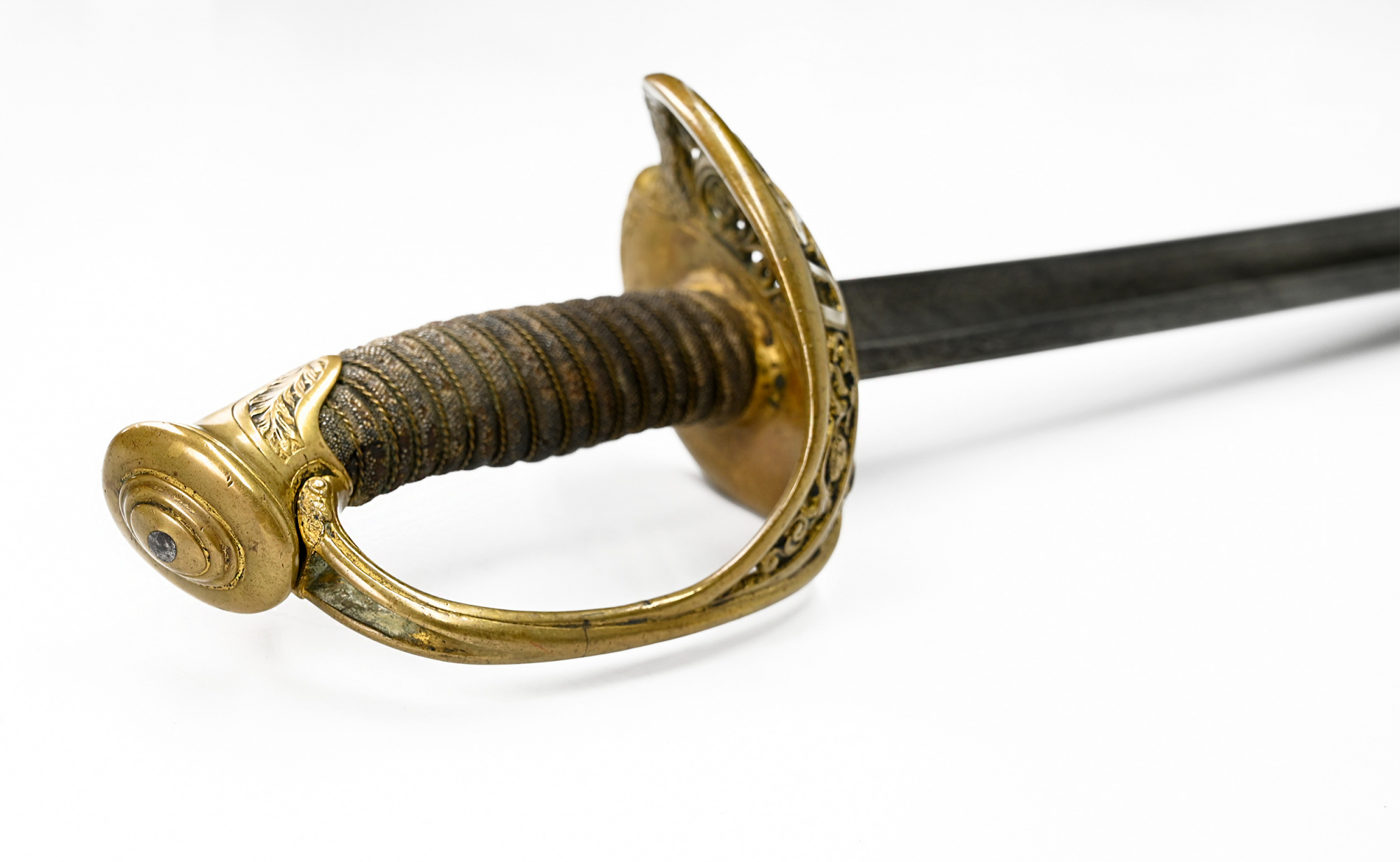
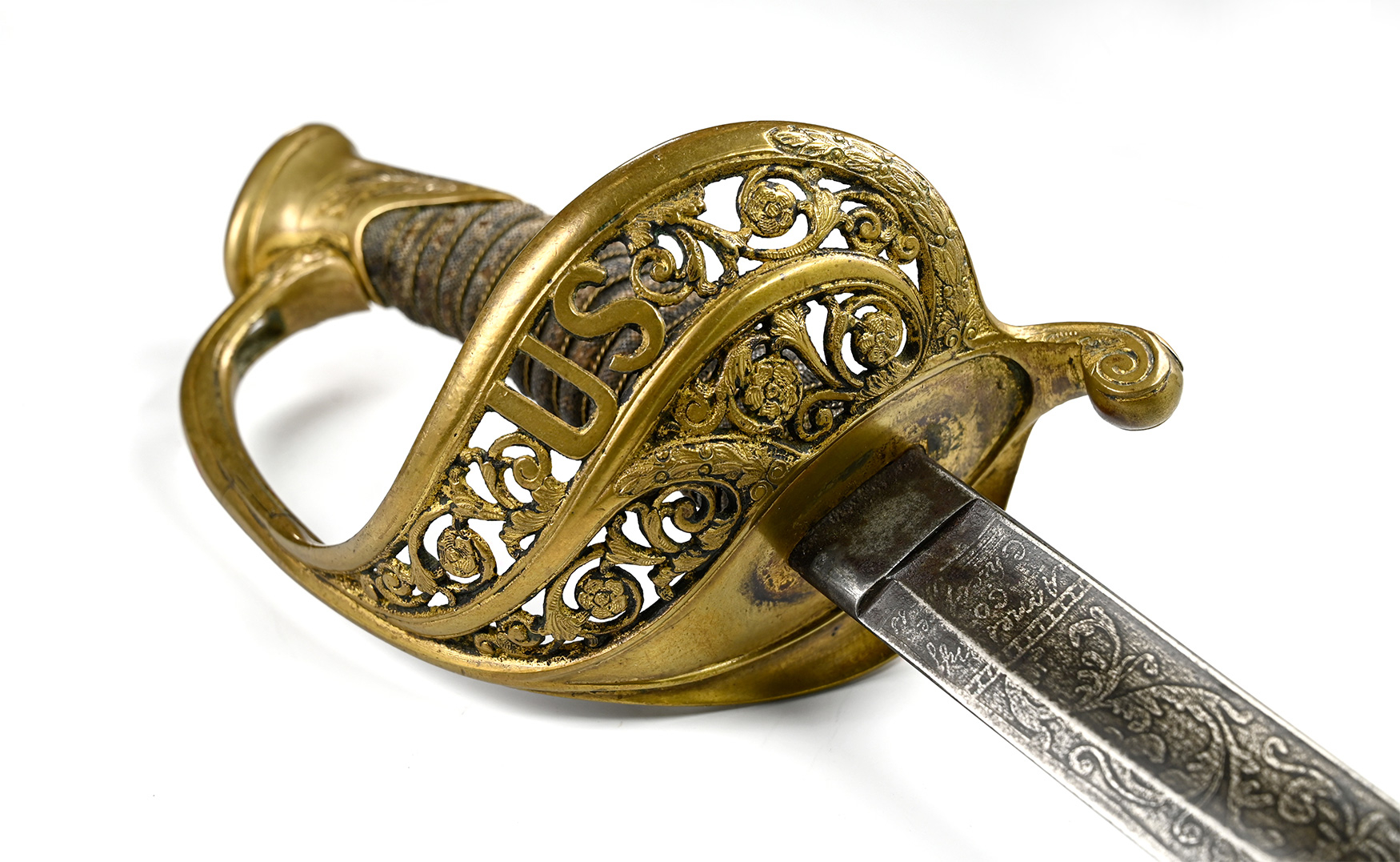
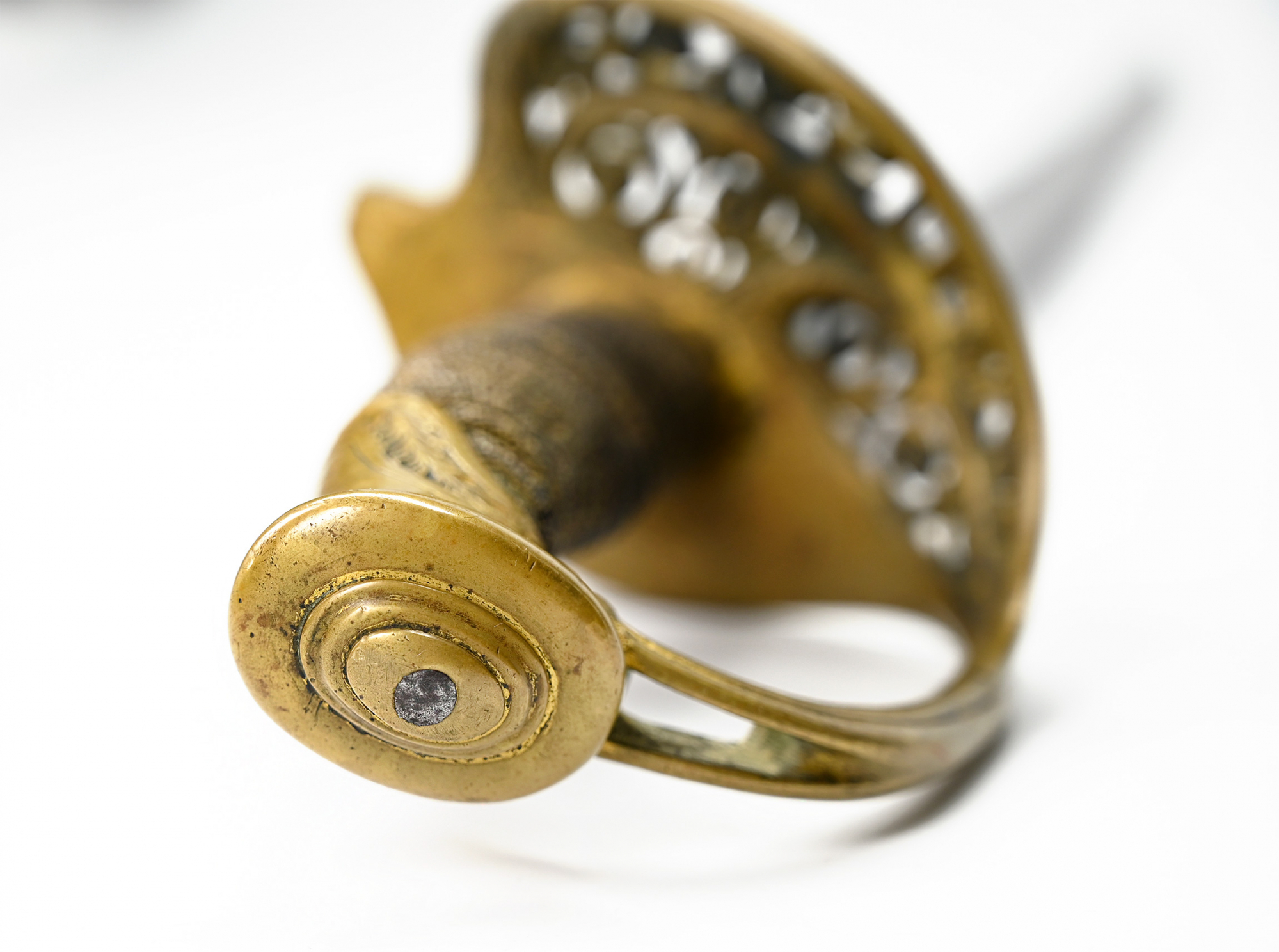
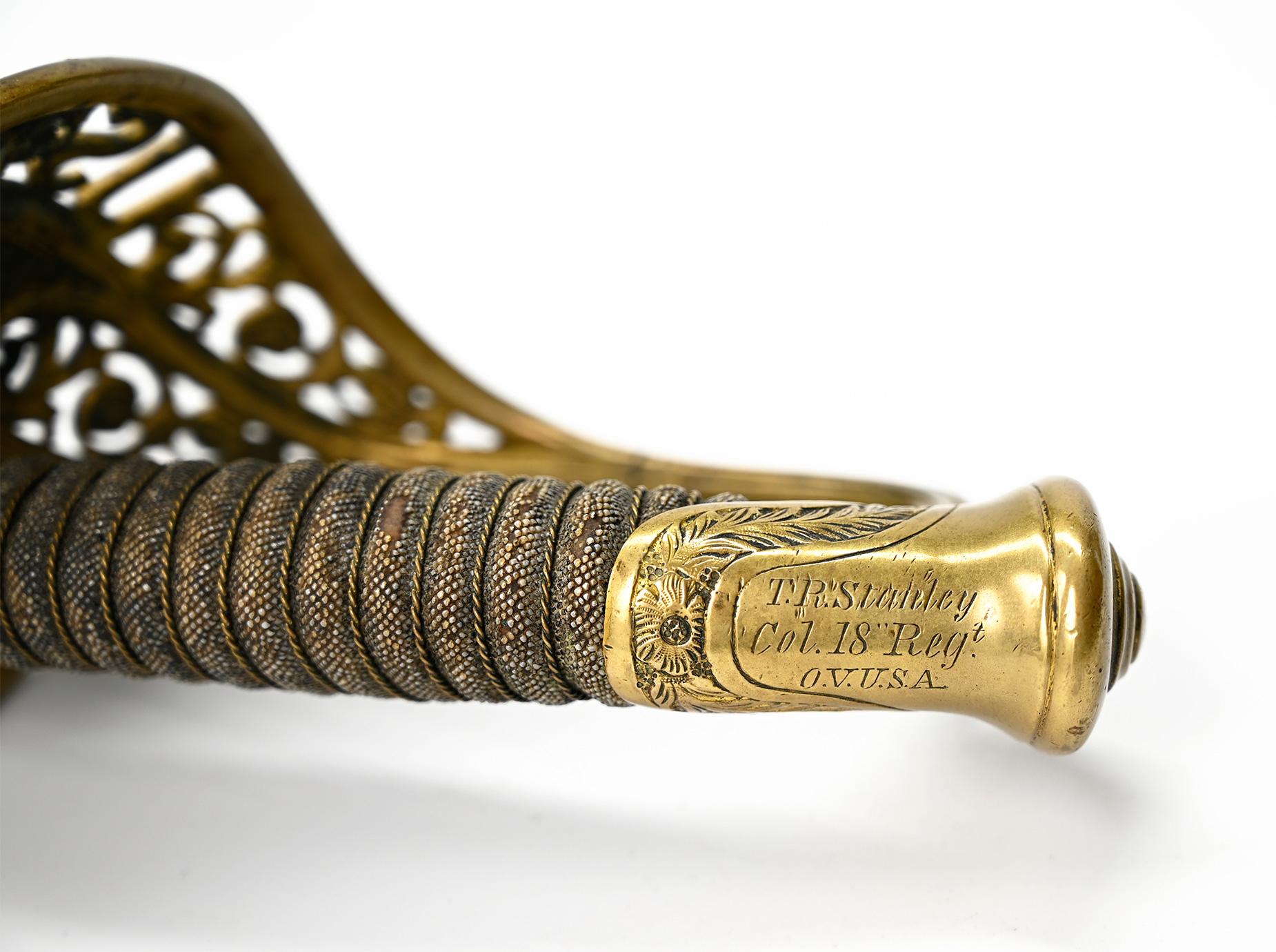
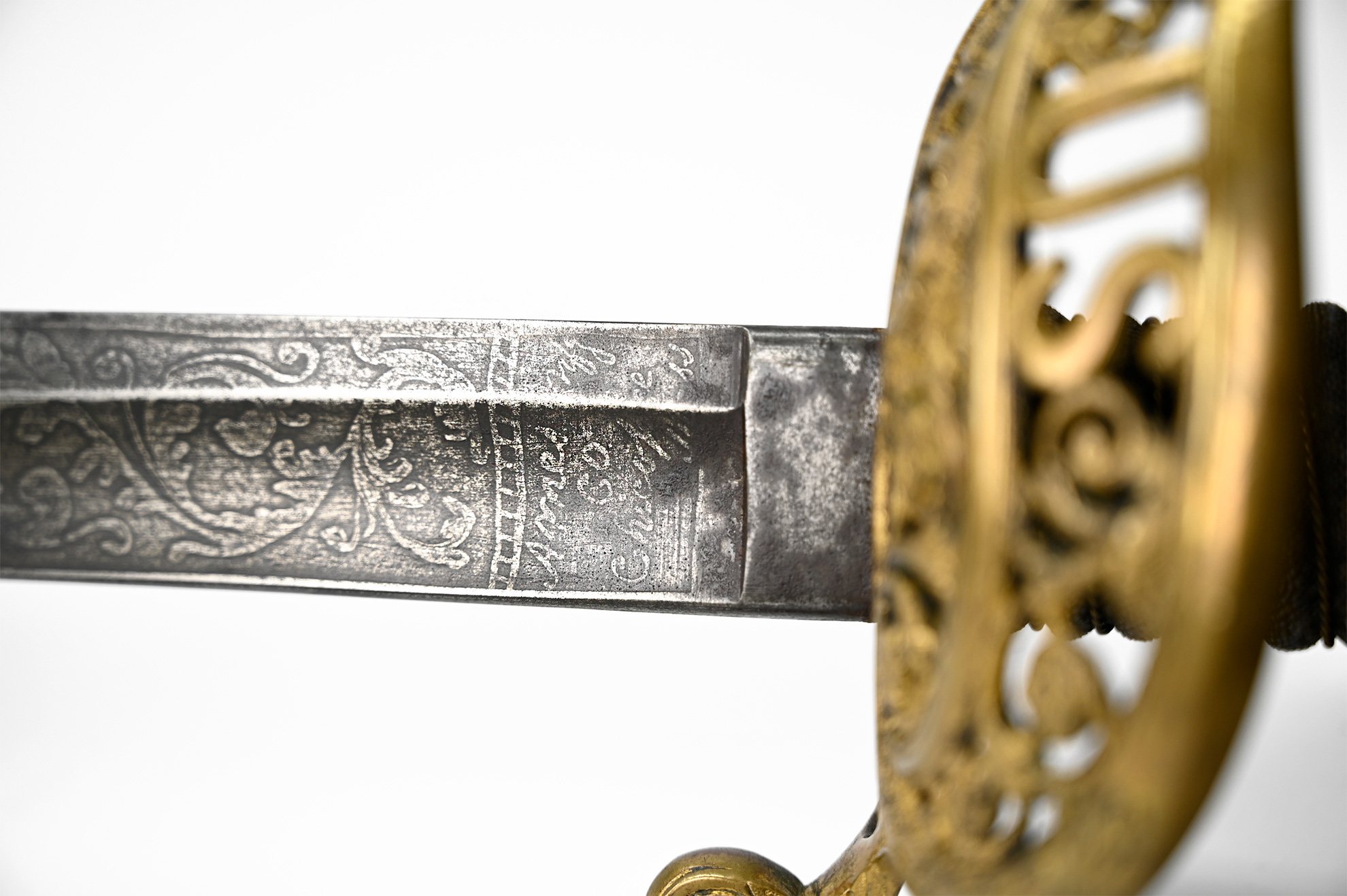
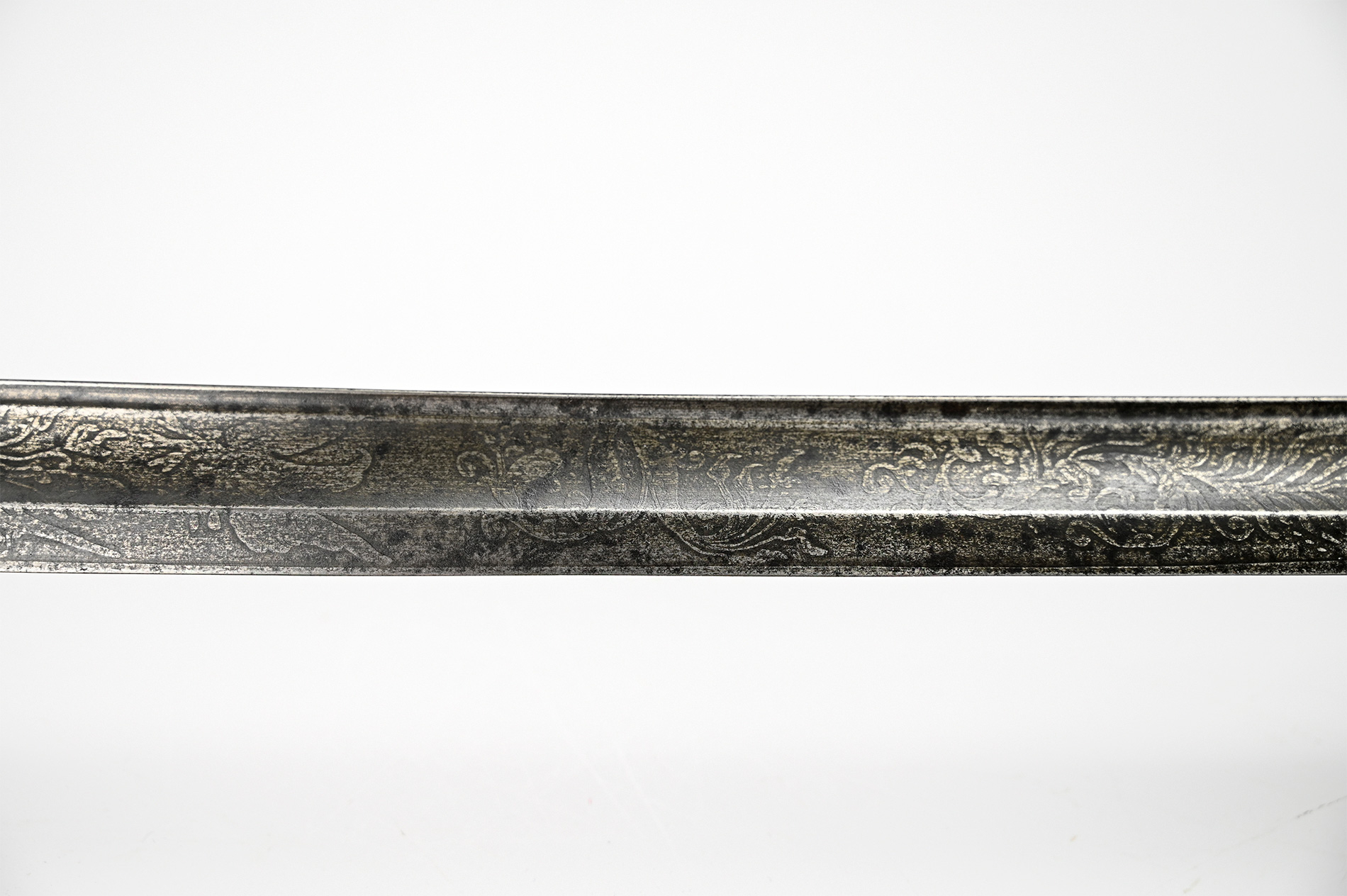
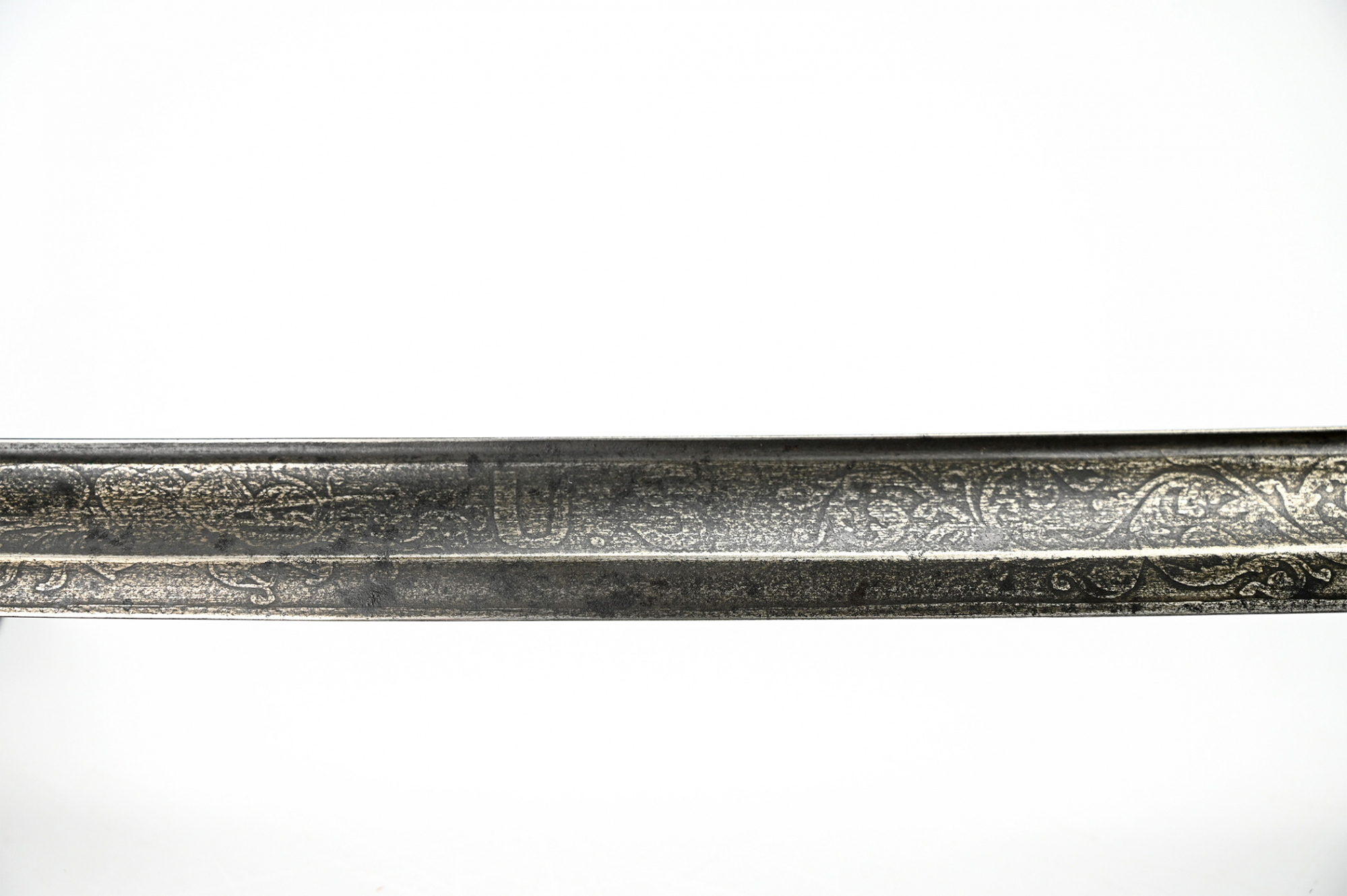
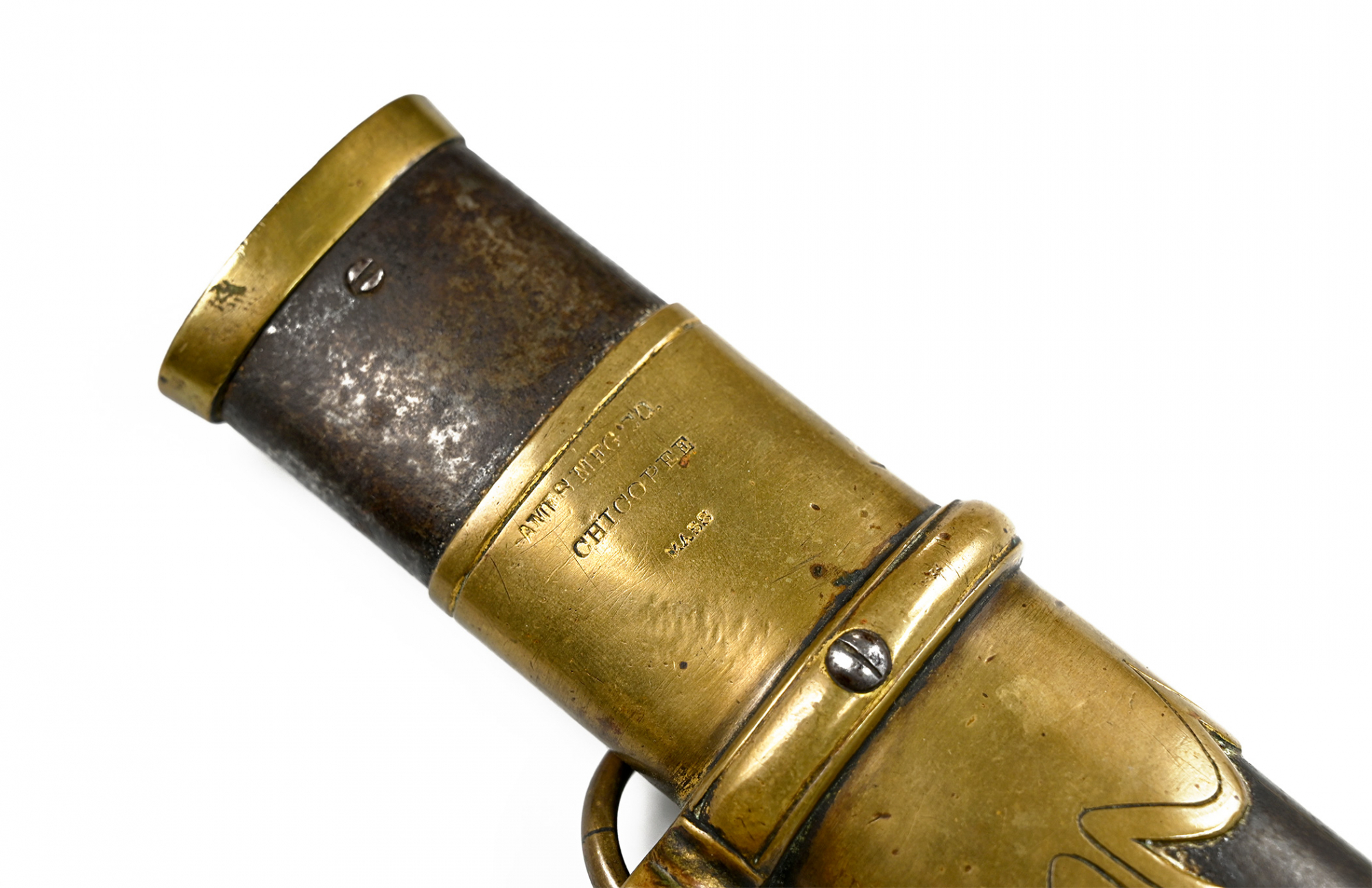
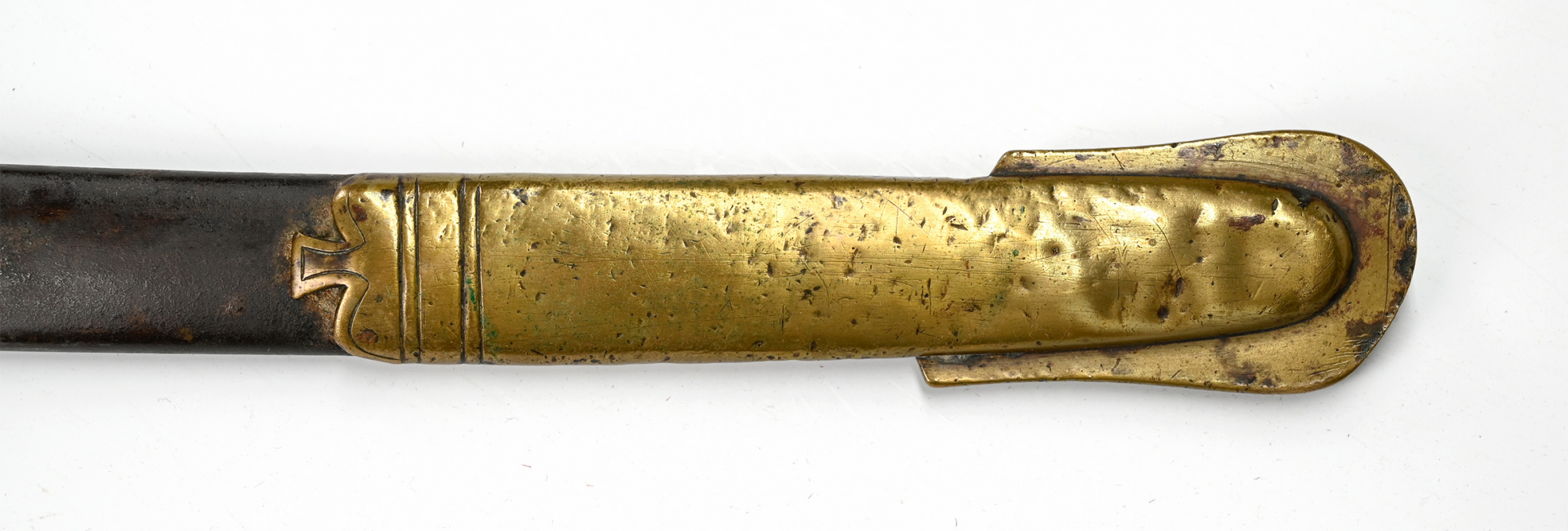
$3,250.00 SOLD
Quantity Available: None
Item Code: 1186-05
This is the nicely inscribed sword of Colonel Timothy Robbins Stanley, who led the 18th Ohio in both its three-month and three-year enlistments, commanded brigades in Negley’s Division at Stones River and Chickamauga, where he was wounded, and led the amphibious portion of the attack at Brown’s Ferry on the Tennessee River that alleviated supply problems for the besieged Union forces at Chattanooga in late 1863. The sword and scabbard are the standard configuration of the Model 1850 sword for staff and field officers as made by Ames. The hilt is brass with the extra guard branches and floating “U.S.” worked into the openwork floral motifs, distinguishing it from the foot officer’s sword. The pommel has leaf decoration along its edge and the grip is sharkskin with a tightly twisted brass wire binding. The blade is single-edged with a spearpoint tip, slightly curved with a broad central fuller and shorter, narrow upper fuller. The scabbard is metal, blued, with brass mounts. The “Ames Mfg./ Co. / Chicopee / Mass” etched address on the obverse blade is fully legible and the scabbard upper ring mount bears a similar stamped marking, though in three lines. The sword shows it was carried in the field, but is in very good condition overall. The hilt has medium aged brass tone with some traces of gilt in recessed spots. The grip wrap shows some areas of wear with loss of nodes from the sharkskin, but has good color and is complete, as is the wire binding. The blade etching is the standard floral scrolls mixed with military and patriotic motifs including a block “U.S.” on one side and at characteristically Ames style eagle with upraised wings and a foliate scroll overhead. Its E Pluribus Unum inscription on the scroll is tougher to make out, but the etching is visible overall, showing as muted silver against the frosted background that has shifted to gray. The scabbard is good as well, showing some typical dings to the drag, but with no bends, dents or breaks to the body, which shows as a mixed of faded blue with some gray, and a few areas of freckling or shallow crustiness. The mounts are all there, complete, and match the hilt.
The pommel is nicely engraved, “T.R. Stanley / Col. 18” Regt. / O.V.U.S.A.” Timothy Robbins Stanley (1810-1874) was born in Connecticut, moved to Ohio with his family in 1815, and became a lawyer, politician and banker, serving in the Ohio legislature 1846 as representative for Lawrence County and was a state senator in 1860 for Meigs, Gallatin, Vinton and Jackson Counties. Stanley organized the 18th Ohio starting in April 1861 and moved with it to Parkersburg, (West) Virginia, where the last of its companies was mustered in on May 29 and he was commissioned as Colonel to that date. This was a three-month regiment that served mostly by detachment, guarding the Baltimore & Ohio railroad between Parkersburg and Clarksburg, supplying guards and escorts for supply trains, and building a telegraph line to Rich Mountain. Stanley mustered out with it on completion of its term on August 6, but was already working on reorganizing the regiment for a three-year term and was commissioned Colonel again to date the same day as his muster out.
The new regiment retained the same numerical designation and served in the Army of the Ohio and 14th Corps, Army of the Cumberland. Stanley’s service largely follows his regiment’s, though both at Stones River and Chickamauga he was in command of the brigade. Dyer’s Compendium lists the regiment’s service as follows: Duty at Elizabethtown and Bacon Creek, Ky., November, 1861, to February, 1862. Advance on Bowling Green, Ky., February 10-15, and on Nashville, Tenn., February 18-25. Occupation of Nashville, Tenn., February 25-March 18. Reconnaissance to Shelbyville, Tullahoma and McMinnville March 25-28. To Fayetteville April 7. Expedition to Huntsville, Ala., April 10-11. Capture of Huntsville April 11. Advance on and capture of Decatur April 11-14. Operations near Athens, Limestone Bridge, Mooresville and Elk River May 1-2. Near Pulaski and near Bridgeport May 1. Moved to Fayetteville May 31. Negley's Expedition to Chattanooga June 1-15. At Battle Creek till July 11. Guard duty along Tennessee & Alabama Railroad from Tullahoma to McMinnville till September. Short Mountain Road and McMinnville August 29 (Cos. "A" and "I"). Retreat to Nashville, Tenn. Siege of Nashville September 12-November 7. Near Lavergne October 7. Duty at Nashville till December 26. Advance on Murfreesboro December 26-30. Battle of Stone's River December 30-31, 1862, and January 1-3, 1863. Duty at Murfreesboro till June. Middle Tennessee or Tullahoma Campaign June 23-July 7. Occupation of Middle Tennessee till August 16. Passage of Cumberland Mountains and Tennessee River and Chickamauga (Ga.) Campaign August 16-September 22. Davis Cross Roads or Dug Gap September 11. Battle of Chickamauga September 19-21. Rossville Gap September 21. Siege of Chattanooga, Tenn., September 24-November 23. Reopening Tennessee River October 26-29. Brown's Ferry October 27. Chattanooga-Ringgold Campaign November 23-27. Orchard Knob November 23-24. Mission Ridge November 25. Engaged in Engineer duty at Chattanooga till October 20, 1864. Mustered out November 9, 1864. Regiment lost during service 4 Officers and 72 Enlisted men killed and mortally wounded and 1 Officer and 107 Enlisted men by disease. Total 184.
Stanley was very well regarded. After Stone’s River, where his brigade was part of the river’s crossing on January 2, more than eighty officers of the brigade signed a letter to the Adjutant General of the U.S. asking for his promotion to Brigadier General of Volunteers and testifying to, “his ability and fidelity as an officer and particularly to his gallantry at the late Battle of Stones River.” (This was dated January 20: even more officers had signed an initial letter that was lost by the orderly assigned to circulate it.) At Chickamauga, where he was wounded (Cozzens, This Terrible Sound, p. 538,) he managed to keep his brigade together in the fighting in Kelly’s Field even while a neighboring brigade dissolved. After that disastrous battle, casualties forced a reorganization that returned him to regimental command, but he again showed some special talents in October, when he was given command of the amphibious portion of the attack on Brown’s Ferry, which opened up the “cracker line,” alleviating supply problems for the besieged Union forces in Chattanooga. This involved manning some fifty pontoon and flat boats, floating them some nine miles down the Tennessee River at night, landing their troops on the southern bank of the river, driving back Confederate pickets, and establishing a beachhead for those boats to then bring over reinforcements who had marched to the northern bank of the river. Stanley himself was on one of the foremost boats in the expedition.
Stanley and the regiment spent the last part of their service in Chattanooga as part of the engineer brigade of the Department of Ohio and Cumberland and he mustered out with his regiment in November 1864. The testimonials from his subordinate and superior officers were among several in his files and his actions abilities were finally recognized, though after he had left the service, with a promotion to brevet brigadier for “gallant and meritorious services during the war” dating to March 13, 1865. Stanley, however, had not let even his final months at Chattanooga go to waste. He seems to have investigated the city and its prospects for the future, settling there at war’s end, establishing the law firm of Stanley, Henderson and Wheeler, and helping found the First National Bank of Chattanooga in September 1865, serving as its vice president until his death there in 1874. [sr] [ph:m]
~~~~~~~~~~~~~~~~~~~~~~~~~~~~~~~~~~~
THIS ITEM, AS WITH ALL OTHER ITEMS AVAILABLE ON OUR WEB SITE,
MAY BE PURCHASED THROUGH OUR LAYAWAY PROGRAM.
CLICK HERE FOR OUR POLICIES AND TERMS.
THANK YOU!
Inquire About INSCRIBED AMES M1850 STAFF AND FIELD SWORD OF COLONEL AND BREVET BRIGADIER GENERAL T.R. STANLEY 18th OHIO, BRIGADE COMMANDER AT STONES RIVER AND CHICKAMAUGA
Most Popular
Historical Firearms Stolen From The National Civil War Museum In Harrisburg, Pa »
Theft From Gravesite Of Gen. John Reynolds »
Selection Of Unframed Prints By Don Troiani »
Fine Condition Brass Infantry Bugle Insignia »
Large English Bowie Knife With Sheath 1870’S – 1880’S »
Imported (Clauberg) Us Model 1860 Light Cavalry Officer's Saber »
featured item
EARLY WAR U.S. CAVALRY OFFICER’S SABER, 1840 STYLE, BY SMITH, CRANE AND COMPANY, NEW YORK, 1858 TO 1862
Smith, Crane and Company pieces are scarce. They were only in business from 1858 through 1862, retailing military goods in New York City. Their swords were imported, of German make and likely by Schnitzler and Kirschbaum, though not maker marked.… (870-263). Learn More »


